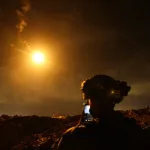Jerusalem, 8 September, 2025 (TPS-IL) — A new edition of Israel’s Red Book of Reptiles, released on Monday, revealed an alarming decline in the country’s reptile populations over the past two decades.
The book, launched by the Israel Nature and Parks Authority in collaboration with Tel Aviv University and the Steinhardt Museum of Natural History, catalogs 92 species, including snakes, lizards, freshwater and land turtles, and sea turtles that nest along Israel’s coasts.
The findings are stark. Many species that were already at risk in 2002 are now in worse condition, with several, such as the Hermon viper, Beersheba lizard, and lowland snake, classified as critically endangered. Others have seen their risk levels drop by two or three categories, reflecting shrinking populations and increasing threats.
“This is a critical moment for Israel’s reptiles, many of which are found nowhere else on Earth,” said Ben Schermeister, a doctoral student at Tel Aviv University who led the book’s renewal. “The Red Book allows us to understand which species are in urgent need of protection and what conservation efforts are most effective.”
The report identifies multiple threats driving the decline. Urban expansion, agriculture, and construction have damaged Mediterranean and desert habitats, while sandy areas are particularly vulnerable to off-road vehicles, sand mining, and military activity. Even Mount Hermon, home to several endemic species, faces pressures from tourism, fires, and climate change. The growth of invasive reptiles, such as the brown anole and red-eared lizard, adds further stress by competing with native species.
Despite the grim outlook, the Red Book notes some successes. Species including the green and brown sea turtles and the river softshell turtle have improved, thanks to targeted conservation programs and better monitoring. These cases demonstrate that intervention can make a tangible difference, even in the face of widespread habitat loss and climate pressures.
Dr. Tal Pollak, head of the Endangered Species Conservation Division at the Nature and Parks Authority, stressed the broader significance of the findings: “Israel’s reptiles are a small but important part of global biodiversity. Their decline is a warning of the risks many species face worldwide and a call for stronger conservation strategies wherever natural habitats are under pressure.”
The updated Red Book is available online for free, offering detailed information on each species’ status and recommendations for conservation. Experts hope that wider public awareness, combined with coordinated action among authorities, scientists, and citizens, can help preserve Israel’s unique and increasingly vulnerable reptile populations.




























